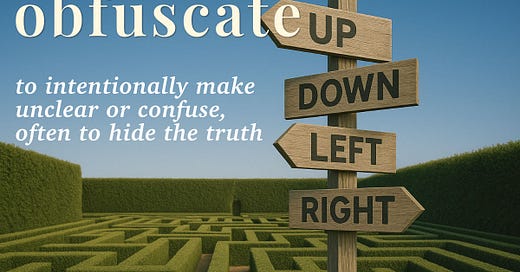obfuscate | SAT Word of the Day
Politicians and marketers have mastered the art of obfuscation. Learn this word today, and add it to your ever-increasing SAT word bank.
⚡️ Quick Quiz: Do you know what OBFUSCATE means already?
obfuscate most nearly means
(A) simplify
(B) highlight
(C) misinterpret
(D) discover
(E) obscure
And one more:
Which of the following actions would most likely be described as obfuscation?
(A) Translating a complex scientific concept into everyday language
(B) Discovering a new species of butterfly in the Amazon
(C) Organizing files alphabetically for easier reference
(D) Using technical jargon and vague language to avoid answering a direct question
(E) Stating your opinion clearly during a spirited debate
Scroll down for the answer/s.
ℹ️ Part of speech of obfuscate
obfuscate is a VERB.
🗣️ Pronunciation of obfuscate
obfuscate is pronounced /ˌɑb.fəˈskeɪt/ or AHB-fuh-skayt.
📚️ Definition of obfuscate
To deliberately make something unclear, confusing, or difficult to understand, often to hide the truth or mislead. Example: to obfuscate the truth.
📰 Examples
Here are some examples of obfuscate in usage:
The CEO attempted to obfuscate the company's financial situation by using complex terminology and vague statements during the presentation.
On the power of obfuscation: "If you can't convince them, confuse them." - President Harry S. Truman
The privacy policy of the social media upstart was written specifically to obfuscate the fact that the app was collecting and selling users' personal data.
✅ Quiz answer/s
Answers:
E, obscure. Explanations: A is the opposite of obfuscate; to simplify is to make clearer, not more confusing. B (highlight) would bring attention to something rather than hide it. C (misinterpret) means to understand incorrectly, not to confuse on purpose. D (discover) means to find or uncover something, which is pretty much the opposite of obfuscate.
D, Using technical jargon... Explanation: This answer describes a classic way to obfuscate—using complex language to avoid giving a straight answer. A describes clarification, not obfuscation. B is about discovery, not hiding or confusing. C describes organization, which effectively makes things clearer. E is about being direct and clear, which again is the opposite of obfuscation.



